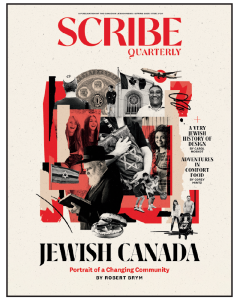Jews love questioning. It’s genetic (see Moses, Job, our forefathers, our actual fathers). And we love questions (see Passover’s Four Questions, “If I am not for myself…”, “You call that smoked meat?”).
While our chutzpadike Yiddish comedy YidLife Crisis can be seen as taking the pish out of organized religion, it came from a place of love and respect for Judaism’s encouragement of questioning, from shuk bargaining to debating with God himself about his own existence! Can you believe the chutzpah? (also a question)
We ourselves have been asked many questions about our show along the way, but the most recurring is “Why Yiddish?”
Like all good Jewish questions, this one has more than one answer.
At first, our instinct to use Yiddish was visceral. Yiddish sounds funny both to Jews and non-Jews. Its cadence, vocabulary, dynamics, they’re just funny. It is hard from the comedic standpoint (where we stand) and not the academic standpoint (where we don’t stand unless we’re told) to articulate why that is, but we feel like most would agree.
As we realized we would do “Seinfeldian” conversations and debates – albeit not ‘about nothing’ but rather the very meaning of what it is to be a Jew in the 21st century – a theory emerged. We wanted to pay tribute to our comic heroes and greatest influencers – Larry David, Jon Stewart, Mel Brooks, Joan Rivers, Jackie Mason – and decided that all of them were essentially performing Yiddish vaudevillian comedy, just in English (kind of like their surnames, their Anglo exterior concealing a rich Yiddish tradition). The cadence, the physicality, the gesticulations, the very phrasing of the humour was inherently Yiddish. So we would reverse engineer it back into the language in which it ‘should have been done.’
Part of our mandate was about bridge building within and outside of our community. Since we intended on setting our “love letter à Montréal” in the Mile End, where cultures collide and where the perception of Judaism may be somewhat narrow, we wanted to portray a different view of Judaism than usually seen there, speaking the very language heard around that shtetl – a language, it should be noted, that was once the third most spoken in Montreal – but purposed in totally multicultural contexts (i.e. spoken while eating poutine at La Banquise), as Yiddish had existed in non-orthodox contexts for years.
But more to the point, we received a great compliment when questioning our own Yiddish abilities (and trust us – others happily questioned with us.) An Orthodox rabbi from Montreal, and native Yiddish speaker, moved us when he said that “Yiddish is not just a language, it is a lens through which we view the world, and in that, you guys are fluent.” And that meant the world to us because, at its core, that is what our show is, and what we feel that Yiddish is – a culture, a shared story, a history, a people, complete with all its wisdom and suffering and neuroses and kvetching and kvelling – all embedded within the language. It uses the Hebrew alphabet, our ancient holy language, and combines it with the eastern European diasporan experience, from Germanic roots to Slavic countries, and for the future, anywhere else we go. It contains it all. It is religious-ish and secular-ish – just like us. And it’s beautiful. And, yes, hilarious.
And as we approach the secular festival of Thanksgiving and pause for a moment of reflection, we thank those that helped make our show possible and watch it, and reflect on the question:
Why Yiddish?
The definitive answer, of course, is, “If I am not for myself, who will be for me? If I am only for myself, what am I? And if not now, when?”
So we answered with a question. What are you going to do?
Chaimie and Leizer are Jamie Elman and Eli Batalion, co-creators of the world’s first online Yiddish sitcom YidLife Crisis.






